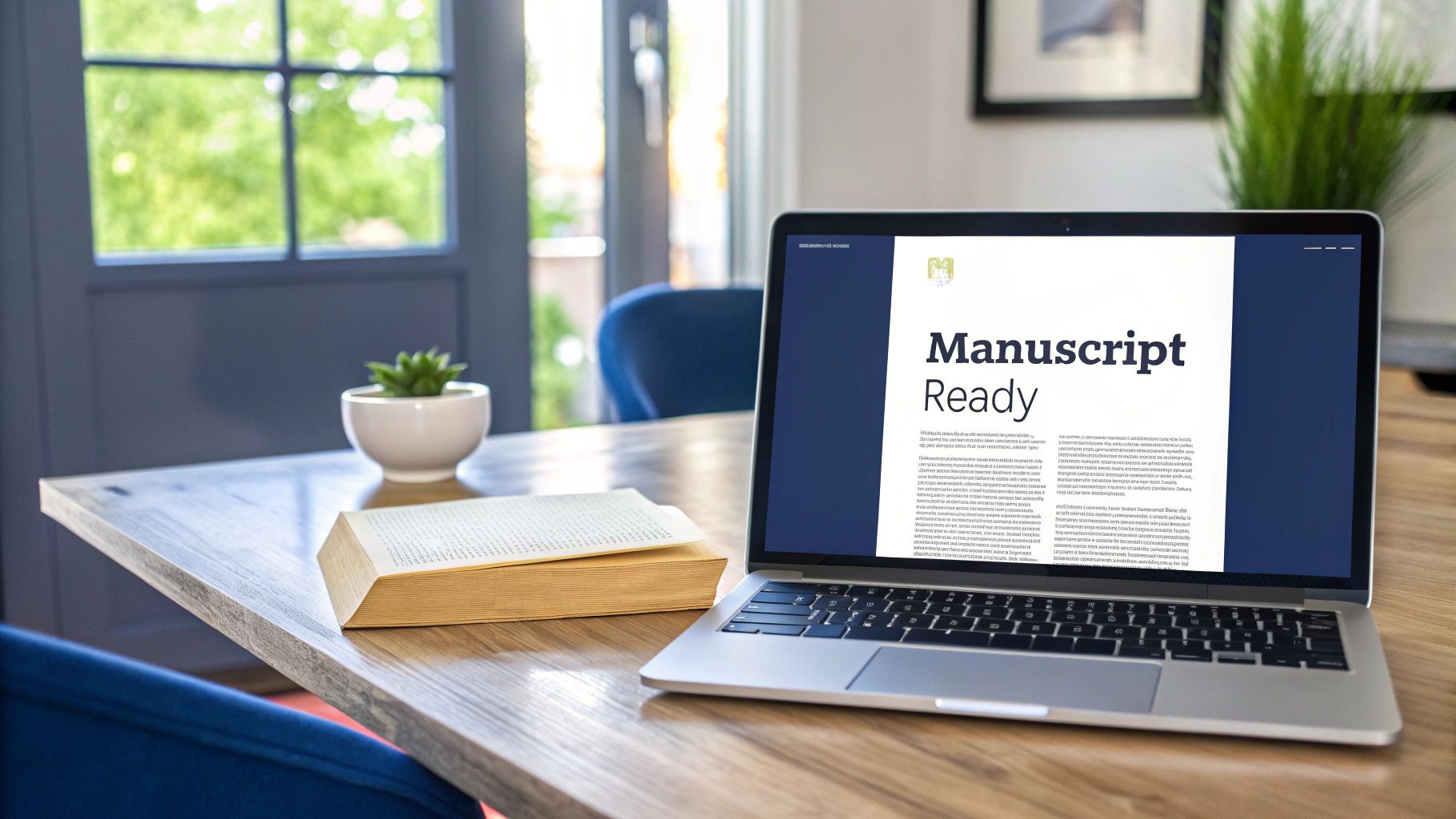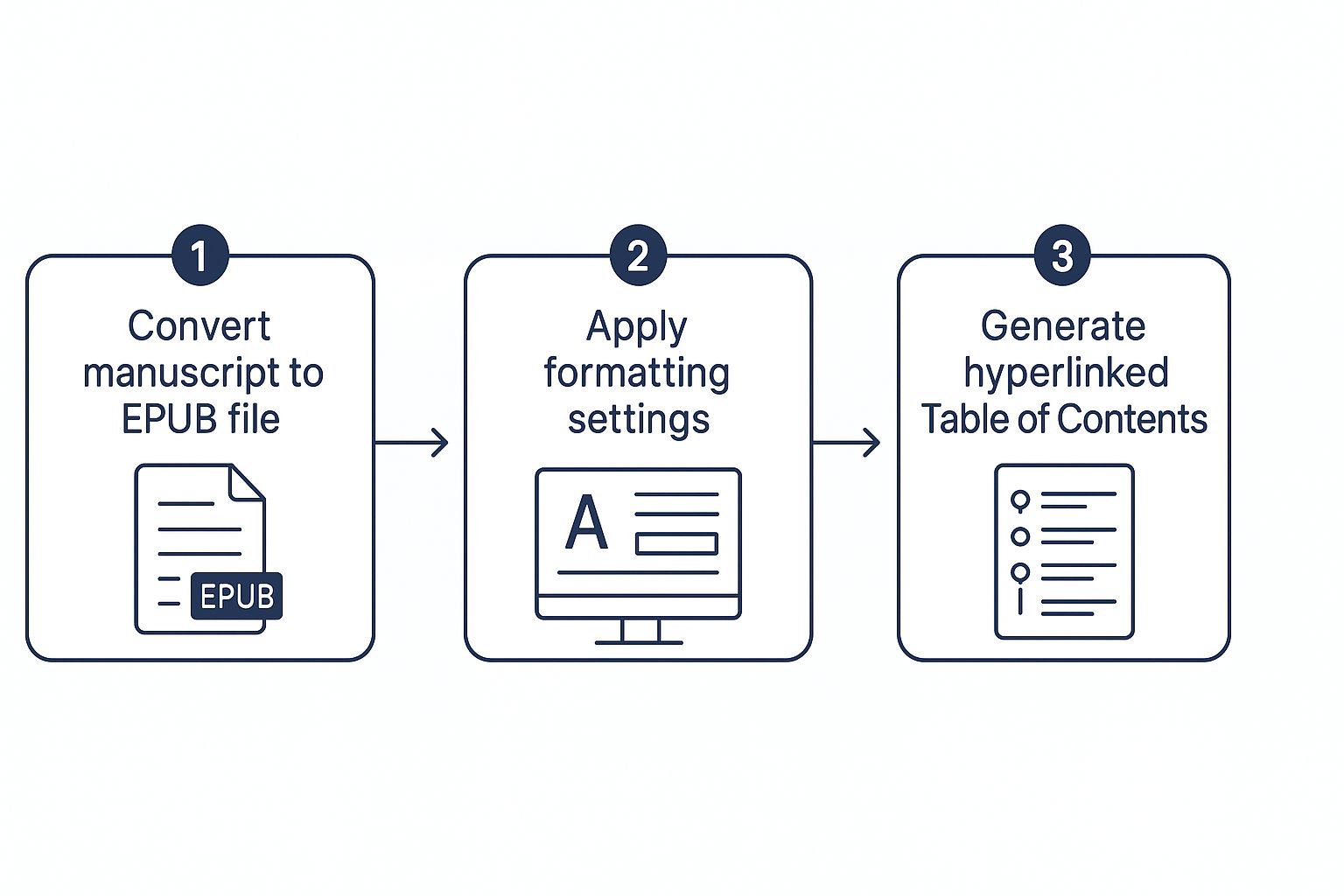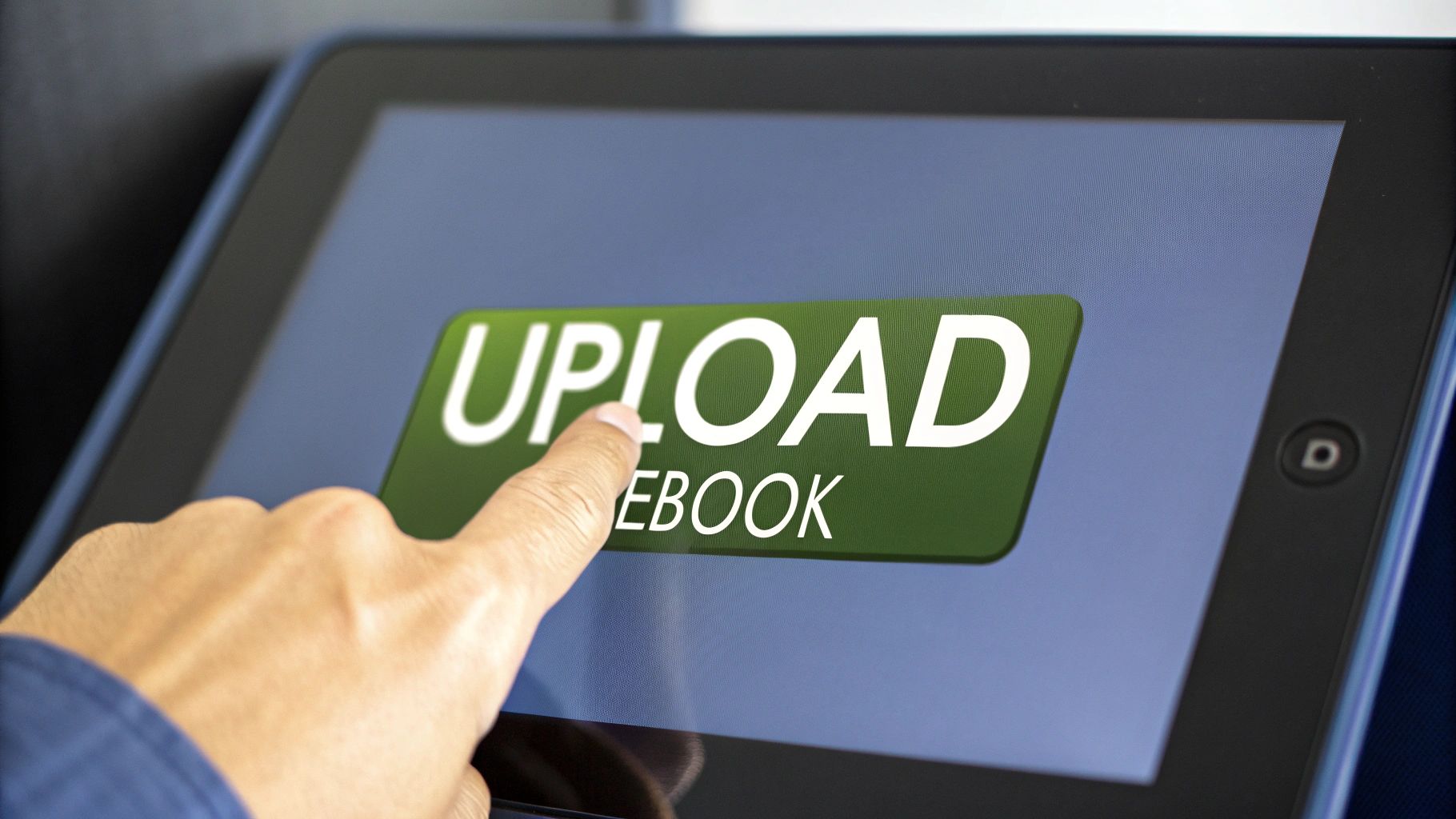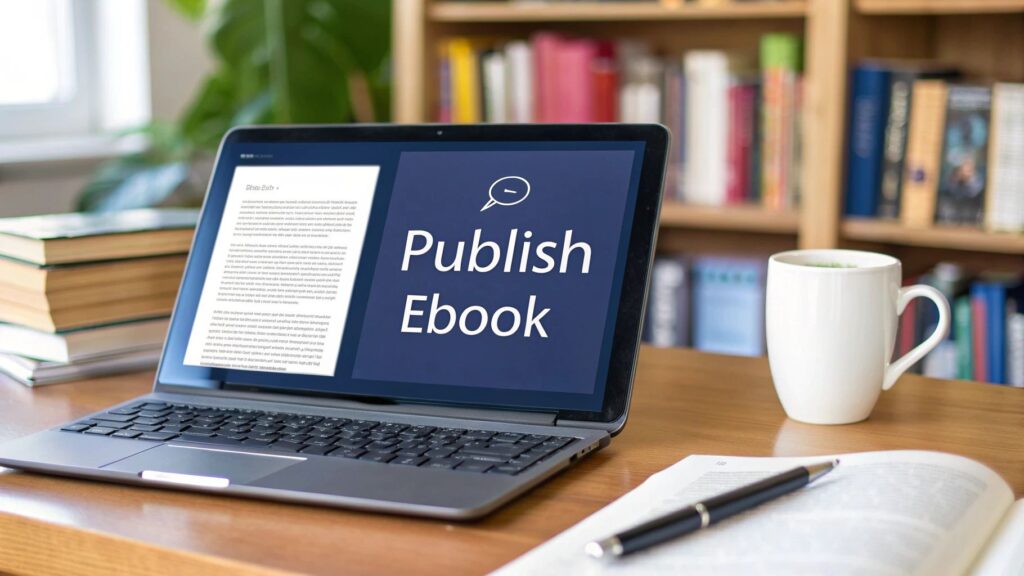So, you've written a book. Congratulations! Now, how do you get it into the hands of readers? For many authors, the answer is Amazon.
Publishing an ebook on Kindle Direct Publishing (KDP) is surprisingly straightforward. At its core, you just need to create a free KDP account, upload your polished manuscript and a great cover, fill in some details about your book, and decide on a price. The whole thing is free, and your book can be live on the world's biggest bookshelf in just a few days, earning you up to 70% royalties.
Your Path To Becoming A Published Author
Think of this guide as your personal launchpad into the world of self-publishing. We're going to pull back the curtain on Amazon's Kindle Direct Publishing platform and show you exactly why it's the go-to choice for independent authors everywhere. This is your roadmap, taking you from a finished manuscript to a live ebook that readers can find, buy, and fall in love with.
The self-publishing scene is exploding. In 2023 alone, more than 2.6 million new self-published books hit the shelves, a 7.2% jump from the year before. And where are most of these authors going? Amazon. It dominates the market, holding about 68% of all ebook sales. That market share, combined with its generous royalty system, makes KDP an incredibly powerful tool for any writer.
Key Stages Of Your KDP Journey
Before you can hit that "publish" button, you need to have your ducks in a row. A professionally edited manuscript is a must. A killer cover is your number one marketing asset. And knowing who you're writing for will shape every decision you make.
Here are the main milestones we'll cover:
- File Preparation: Making sure your manuscript and cover files are formatted correctly for KDP.
- Book Details: Writing a book description that sells, picking the right keywords, and choosing categories that get you discovered.
- Pricing and Royalties: Smartly pricing your book for maximum profit and figuring out if KDP Select is a good fit.
- Publishing and Promotion: Finally clicking "publish" and using simple strategies to give your book a strong launch.
Your book cover is what makes a reader stop scrolling, but it's your description that makes them click "buy." A great blurb creates intrigue, tells the reader what to expect, and makes an emotional connection. If it doesn't make them feel like they have to know what happens next, they're gone.
Before we dive into the nitty-gritty of the KDP platform, here's a quick look at the essential pieces you'll need to have ready.
KDP Publishing Checklist At a Glance
This table breaks down the core components you'll need to prepare. Having these assets and decisions ready beforehand will make the upload process smooth and stress-free.
| Component | Key Consideration | Why It Matters |
|---|---|---|
| Manuscript File | Professionally edited and formatted (EPUB or DOCX). | A clean, error-free file ensures a good reader experience and avoids negative reviews. |
| Cover File | High-resolution (JPEG/TIFF) and designed to genre standards. | This is your single most important marketing tool. It has to grab attention instantly. |
| Book Title & Subtitle | Clear, intriguing, and contains relevant keywords if non-fiction. | Your title is the first hook. A good subtitle can clarify the premise or promise. |
| Book Description | Compelling sales copy with a strong hook and clear call to action. | This is your chance to convince a potential reader to buy your book. |
| Keywords (7) | Specific, relevant terms readers would use to find a book like yours. | These are crucial for discoverability in the Amazon store. Think like a reader. |
| Categories (2) | Niche categories that accurately reflect your book's genre. | Placing your book in the right "aisle" helps the right readers find it. |
| Pricing Strategy | Choose between the 35% or 70% royalty option. | This directly impacts your earnings per sale and your book's perceived value. |
Having these items thought out will turn a potentially overwhelming task into a simple checklist.
The journey to becoming a published author has never been more accessible. While this guide focuses on the technical steps for the Amazon platform, never forget that it all starts with strong writing. If you're looking to sharpen your skills, this guide for aspiring writers on how to start content writing is a great resource.
For a higher-level view of the entire author journey, from writing the first word to building a career, you can also explore our guide on how to become a published author.
Getting Your Manuscript and Cover Ready for Prime Time

Before you even touch the KDP dashboard, we need to talk about the two most critical assets you own: your book’s interior and its cover. I’ve seen countless authors rush this part, and frankly, a sloppy manuscript or a cringe-worthy cover can kill a book before it ever gets a chance.
Readers today have incredibly high standards. They're used to a polished, professional experience, and anything that feels amateurish can lead to a flood of bad reviews that will torpedo your sales. Think of your manuscript and cover as the foundation of your publishing business—if it's weak, the whole thing comes crumbling down.
Formatting Your Manuscript Like a Pro
Your manuscript is the soul of your book. Getting the formatting right isn't just about aesthetics; it’s about making sure your story is readable and looks great on every Kindle device and app out there. A poorly formatted book is jarring, pulling the reader right out of the world you’ve built.
KDP accepts a few different file types, but the main players are DOCX (from Microsoft Word), EPUB, and KPF (Kindle Package Format). While you can just upload a Word document and hope for the best, I've found that taking the extra step to create a clean EPUB file gives you far more control and a more reliable result.
Here are a few interior design rules I never break:
- Stick to classic fonts. For the body of your text, use something timeless and easy on the eyes, like Times New Roman or Garamond. Save the fancy, decorative fonts for your chapter titles, if at all.
- Give each chapter a fresh start. Every new chapter must begin on its own page. The right way to do this is with the "Page Break" function in your word processor, not by mashing the Enter key.
- Make your Table of Contents (ToC) clickable. This is non-negotiable for ebooks. Readers expect to tap a chapter title in the ToC and jump straight there. Most formatting tools can build this for you automatically.
A reader's trust is earned one page at a time. Clean formatting, consistent spacing, and an easy-to-navigate structure aren't just minor details—they're a signal that you respect the reader's time and money. A single typo might be forgiven, but a messy layout feels like a broken promise.
Your Cover Is Your #1 Salesperson
Imagine your book on a crowded digital shelf. That's Amazon. Your cover is doing all the hard work here—it's your ad, your first impression, and your sales pitch rolled into one. A fantastic, professional cover can skyrocket your clicks. A bad one guarantees readers will scroll right on by.
A great cover does three things in the blink of an eye:
- It screams the genre (think dark and moody for a thriller, or bright and whimsical for a cozy romance).
- The title is crystal clear, even when it's just a tiny thumbnail image.
- It creates an emotional hook, making someone stop scrolling and think, "Ooh, what's this about?"
Choosing Your Cover Design Path
You've got a few ways to get a cover made, and each comes with its own price tag and trade-offs. This is a real business decision, so let's break it down.
Amazon's Cover Creator
This is KDP's free, built-in tool. It’s an option if your budget is literally $0, but the templates are very limited. The risk is that your book will end up looking generic and screaming "amateur" to seasoned readers who know what to look for.
Hiring a Professional Designer
For any author who is serious about selling books, this is the way to go. A pro who specializes in your genre already knows the market trends and what visual cues make readers click "Buy Now." You can find incredible designers on platforms like Reedsy or 99designs, or simply by finding authors in your genre whose covers you love and seeing who they hired.
If you're looking for unique imagery, you could even explore an AI image generator specifically designed for book covers to help create concepts or even final art.
To get the most out of working with a designer, you need to give them a killer creative brief.
A great brief always includes:
- The vitals: Your final book title, subtitle, and author name.
- Genre and target audience: Is this a gritty military sci-fi for men over 40 or a sweet small-town romance for women under 30? Be specific.
- A quick synopsis: A short paragraph that captures the tone and key story elements.
- Examples you love (and hate): This is the most important part. Send them links to 3-5 book covers in your genre that you absolutely love, and explain why. It’s just as helpful to show them a few you dislike.
Putting money into a well-edited manuscript and a professional cover isn't an expense—it's the single best investment you can make in your book's future.
A Guided Tour of the KDP Dashboard
This is where all your hard work pays off. After the writing, endless edits, and cover design debates, the Kindle Direct Publishing (KDP) dashboard is where your manuscript finally becomes a real book that people can buy.
When you first log in, it can look a little overwhelming. Don't worry. It's actually a pretty straightforward process broken into three main sections: eBook Details, eBook Content, and eBook Pricing.
Let's walk through it screen-by-screen. I'll break down every field and setting so you know exactly what you’re doing. Once you've created your free KDP account and hit "Create," this is where you'll start.
First Up: Your eBook Details
This tab is all about your book's metadata. Think of it as the information that helps Amazon's algorithm—and more importantly, actual readers—find your book. Getting this right is absolutely critical for discoverability.
You’ll start with the basics: language, book title, and subtitle. Then you'll add your author name. Pen names are totally fine here, so don't hesitate to use one if that's your plan. You can also add contributors like editors or illustrators if you want to give them credit.
Now for the most important part of this page: the book description. This is your sales pitch. A good description needs to hook the reader, tell them what to expect, and create a genuine connection. You can even use some basic HTML to make it pop.
<b>and</b>are perfect for bolding an attention-grabbing first line.<i>and</i>can be used for italicizing key phrases for emphasis.<ul>and<li>help you create bulleted lists that are easy to skim.
I see so many authors just paste a huge wall of text here. Big mistake. Start with a bold, punchy hook. Break your paragraphs up. Use a bulleted list to highlight what makes your book great. You want someone to be able to scan it and get excited in just a few seconds.
Next, you'll tackle your keywords and categories. These are the signposts that tell Amazon where to shelve your book digitally. You get to pick up to seven keyword phrases and two categories.
For instance, if you wrote a historical fantasy novel, your keywords might be "magic in medieval Europe," "knights and sorcerers," or "epic fantasy with political intrigue." For categories, you might select Fiction > Fantasy > Epic and maybe a niche one like Fiction > Fantasy > Historical. Spend time on this—it's how the right readers will find you.
Getting Your Files Ready: The eBook Content Tab
With your book's details squared away, it’s time for the main event: uploading the manuscript and cover.

Before you even get to this KDP page, make sure your file is clean and has a hyperlinked Table of Contents. This single step makes a huge difference in how professional your ebook feels to the reader.
You’ll see a big button to "Upload eBook manuscript." Amazon accepts a few file types, including DOCX, but I strongly recommend using a properly formatted EPUB file. Why? Because an EPUB gives you the most control over how your book looks on a Kindle, which means fewer ugly formatting surprises later on.
After the manuscript, you'll upload your cover. KDP offers a free Cover Creator tool, but honestly, a professional cover is a non-negotiable investment. Assuming you have one, you'll just click "Upload a cover you already have" and add your high-res JPG file.
Once both files are in the system, you absolutely must use the KDP Online Previewer. This tool shows you exactly what your book will look like on different devices—a Kindle, a tablet, even a phone. Click through every single page. Seriously. Look for:
- Weird formatting glitches or spacing issues
- Awkward page breaks in the middle of a sentence
- Images that look blurry or are poorly sized
- That your cover displays perfectly
Finding an error here is a minor inconvenience. Finding one after you've published can lead to a string of bad reviews. This is your last chance for quality control.
Finally, you’ll see the Digital Rights Management (DRM) option. DRM is meant to stop people from illegally sharing your ebook. My advice? Don't enable it. Most experienced indie authors agree. It often just frustrates honest customers who want to read their book on different devices and does very little to stop actual pirates.
Let's Talk Money: Setting Your Price and Royalties
The last tab is where you decide on your price and see how much money you’ll make. This is the fun part!
First, you have to decide whether to enroll in KDP Select. Enrolling gets you into the Kindle Unlimited library and gives you access to some great promo tools, but it comes with a catch: you have to give Amazon exclusive rights to sell your ebook for a 90-day period.
Next, you'll set your list price and choose a royalty rate: 35% or 70%. This is a no-brainer for most authors. To get the 70% royalty, you have to price your ebook between $2.99 and $9.99. If your price is higher or lower than that, you drop to 35%. For almost any full-length book, hitting that 70% sweet spot is the way to go.
Once you type in a price, KDP shows you your estimated royalty per sale after taking out a tiny delivery fee based on your book's file size. You can also set different prices for all the international Amazon stores.
After giving everything one final look, you’ll hit that big yellow button: "Publish Your Kindle eBook." And that's it! Your book is officially submitted. It usually takes less than 72 hours for it to be reviewed and go live in Amazon stores around the world.
Deciding on Your Pricing and Royalty Strategy

Alright, you've made it to the final big decision before you hit that "Publish" button. Don't gloss over this part—your pricing and royalty choices will have a huge impact on your book's success. This isn't just about picking a random number; it's a strategic move that positions your book in the market, builds sales momentum, and ultimately determines how much you earn from all your hard work.
The KDP dashboard makes the process straightforward, letting you set up your ebook, paperback, and even audiobook versions all in one place. Amazon's royalty structure is pretty clear-cut: you can earn up to 70% on ebooks and a flat 60% on paperbacks (minus printing costs). Payouts come monthly, about 60 days after the end of the month in which a sale was made.
Hitting the 70% Royalty Sweet Spot
For most authors publishing an ebook, the primary goal is to secure that sweet 70% royalty rate. This is where you get to keep the largest chunk of every sale. To qualify, your ebook has to meet a few conditions, but the most important one is its price.
To earn 70% royalties, your book's list price must be between $2.99 and $9.99.
If you price your book lower than $2.99 (like at $0.99 or $1.99) or higher than $9.99, your royalty rate gets slashed to 35%. This pricing window is Amazon's way of guiding authors toward what it sees as a fair market value for digital books. Honestly, for almost any full-length novel or nonfiction book, sticking within this range is the only way to go financially.
This decision also plays directly into your marketing plan. A very common and effective tactic for new authors is to launch at $2.99. This lower price encourages early readers to take a chance on you, which helps you collect those all-important first reviews. Once your book has built up some social proof, you can confidently nudge the price up to $3.99, $4.99, or whatever seems to be the standard in your genre. To really get into the weeds on this, our guide on how to price your book for success is a great next step.
Don't just pull a price out of thin air. Spend an afternoon browsing the top 100 bestsellers in your most specific Amazon category. What are the most common price points? Pricing your book similarly sets reader expectations and makes it feel like it belongs on that digital shelf.
The Big Decision: KDP Select Exclusivity
Just before you finalize everything, Amazon will present you with a crucial choice: enrolling your ebook in KDP Select. This is a big deal with some significant trade-offs you need to understand.
Enrolling in KDP Select means you are granting Amazon exclusive rights to sell your ebook for a 90-day period. During this term, you absolutely cannot list your ebook for sale on other platforms like Apple Books, Kobo, or Barnes & Noble. This enrollment automatically renews every 90 days unless you manually go in and opt out.
So, what do you get in return for this exclusivity? Amazon gives you access to a couple of its most powerful promotional tools.
- Kindle Unlimited (KU): Your book is added to the Kindle Unlimited library. Subscribers pay a monthly fee to read as many books as they want, and you get paid for every page they read in your book. This can be a fantastic source of steady income, especially from readers who devour books.
- Kindle Countdown Deals: This tool lets you run a time-sensitive discount on your book for up to seven days. A visible countdown timer creates a sense of urgency and can dramatically boost sales and your book's ranking.
- Free Book Promotions: You can make your book free for up to five out of every 90 days. This is an incredibly popular strategy for the first book in a series, as it's a risk-free way to get readers hooked on your writing and eager to buy the next installment.
Whether KDP Select is right for you is a business decision that depends entirely on your goals. Some authors want to build a wide audience across many stores, while others prefer to focus their efforts on Amazon's massive ecosystem.
Here’s a quick breakdown to help you decide.
Standard KDP vs KDP Select
| Feature | Standard KDP | KDP Select |
|---|---|---|
| Distribution | Sell on any platform (Amazon, Apple, Kobo, etc.) | Exclusive to Amazon for 90-day terms |
| Kindle Unlimited | Not available | Your book is included in the KU library |
| Promotional Tools | Standard Amazon Ads | Access to Countdown Deals & Free Promotions |
| Best For | Authors wanting to "go wide" and build a presence across multiple retailers. | Authors focused on maximizing visibility and tools within the Amazon ecosystem. |
From my experience, many new authors find it beneficial to enroll in KDP Select for the first 90 or 180 days. It’s a powerful way to gain initial traction on the world's biggest bookstore. You can always opt out later and take your book "wide" to other retailers once it has a solid foundation of sales and reviews.
Marketing Your Book After You Hit Publish
You did it. You hit "Publish." Take a moment to celebrate that win, because it’s a big one. But don't get too comfortable—this is where the real work begins. A brilliant book can easily vanish on Amazon without a solid marketing push right out of the gate.
Think of the first few weeks as your chance to make a good impression on Amazon’s algorithm. Every sale and every Kindle Unlimited borrow is a signal that people are interested. This is what gets your book noticed and starts a domino effect, pushing it into those coveted "also-bought" carousels and category bestseller lists.
Gathering Your First Ethical Reviews
Let’s be honest: a book with zero reviews looks risky. Social proof is king on Amazon. Your first job is to get a handful of honest reviews up on your book’s page, and fast. The magic number seems to be around 10-15 reviews—that’s often when Amazon’s algorithm really starts to pay attention.
This is not about buying reviews (don't ever do that). It's about being strategic. Start with your inner circle. Reach out to friends, family, and colleagues who you know will give you genuine feedback.
Here’s a simple, no-pressure template you can steal and adapt:
"Hi [Name], I'm so excited to share that my new book, [Book Title], is officially live on Amazon! As one of my early supporters, I was hoping you might be willing to read it and leave a quick, honest review. It would mean the world to me and make a huge difference in helping other readers find it. Here's the link: [Your Amazon Link]. Thank you so much!"
For your next book, level up by building an ARC (Advance Reader Copy) team. These are dedicated fans who get a free, early copy in exchange for leaving an honest review during launch week. It's a game-changer.
Activate Your Author Platform
Your author platform is anywhere you can talk directly to your readers—your email list, social media, your blog. During launch week, these are your most valuable assets.
Your email list is your goldmine. You own it. No algorithm can hide your messages. Send a launch day email with a clear, enthusiastic call to action and a direct link to your Amazon page. Make it an event!
On social media, you can:
- Create launch graphics: Use a tool like Canva to design some eye-catching visuals with your book cover.
- Go live: Jump on Instagram or Facebook for a live Q&A. Talk about the book, read a short excerpt, and let your personality shine.
- Share testimonials: Drip-feed quotes from beta readers or positive feedback you’ve already received.
The goal is to build genuine buzz and make your audience feel like they're part of something special. If you want to dig deeper into promotional tactics, our guide on how to promote your book on Amazon has a ton of advanced strategies.
Using Amazon’s Built-in Marketing Tools
Amazon wants you to sell books—it’s how they make money, too. So, they give you some powerful tools right inside the KDP dashboard.
First, get your Amazon Author Central profile dialed in. This is your author storefront on Amazon. Upload a professional headshot, write a bio that connects with readers, and link to your blog or website. It instantly makes you look more credible.
Next, it’s time to think about Amazon Ads. Don't be intimidated. Even a small budget of $5-$10 per day during your launch can give you a massive visibility boost. A great starting point is an "Automatic Targeting" campaign. You just set it and let Amazon’s system find shoppers who are already looking for books like yours.
Thinking strategically about timing can also give you an edge. For instance, knowing some Amazon Prime Day marketing tips can help you piggyback on one of the biggest shopping events of the year.
Your launch is a sprint at the start of a marathon. A strong start is absolutely critical. By focusing on getting those initial reviews, firing up your platform, and using Amazon's own tools, you’re giving your book the best possible shot at finding its audience and achieving long-term success.
Answering Your Final KDP Questions

You’ve done the hard work of writing and formatting your book. Now, as you stand on the verge of hitting "Publish," a few nagging questions always seem to pop up. Don't worry, this is completely normal.
Let's clear up some of the most common sticking points that new authors run into. Getting these details straight will give you the final boost of confidence you need.
Do I Really Need an ISBN for My Kindle Ebook?
This is probably the most frequent point of confusion, and the answer is refreshingly simple: No, you do not need to buy an ISBN for your Kindle ebook.
When you upload your book to KDP, Amazon assigns it a unique 10-digit ASIN (Amazon Standard Identification Number). This ASIN acts as the book's exclusive identifier on their platform, so you're all set.
Now, if you're also creating a paperback through KDP, they will offer you a free ISBN. The catch? This free ISBN is tied to Amazon's ecosystem. If you ever want to sell that print book through other retailers or distributors, you'll need to purchase your own.
How Quickly Will My Book Actually Go Live?
After all those hours of writing, the wait to see your book on the digital shelf can feel like an eternity. Thankfully, it's usually not a long one.
Once you click "Publish," your book enters Amazon's review queue. Officially, they say this can take up to 72 hours.
From my own experience publishing dozens of books, it's almost always faster. I’ve seen most ebooks go live within 24 hours, and sometimes in as little as 12. You'll get that exciting confirmation email the moment your book is available for sale.
One of the most powerful things about KDP is that your book is never set in stone. Found a typo a week after launch? Want to update your cover design six months from now? You can.
The ability to update your book on the fly is a game-changer. Just log into your KDP dashboard, upload the revised manuscript or cover file, and republish. The new version goes through the same review process and is typically live within 24-48 hours. You can even choose to notify past buyers that an updated version is ready for them to download.
How (and When) Do I Get Paid?
Let's talk money. KDP pays authors via monthly royalties, but it’s important to understand the timing. Payments are sent approximately 60 days after the end of the month where the sales happened.
For example, your royalties from sales in January will land in your bank account at the end of March. Depending on where you live, you can choose to be paid by direct deposit, wire transfer, or a physical check.
The royalty structure is what makes KDP so attractive. You can earn:
- A 70% royalty for ebooks priced between $2.99 and $9.99.
- A 60% royalty for paperbacks sold on Amazon.
Keep in mind, KDP's in-house printing is focused on ebooks and paperbacks. For hardcovers or audiobooks, you'll need to work with other platforms. If you're weighing your options, exploring comparisons of popular self-publishing platforms can provide a lot of clarity.
Navigating the world of self-publishing can feel complex, but you don't have to do it alone. At BarkerBooks, we help authors transform their manuscripts into professionally published books. From editing and cover design to global distribution and marketing, our expert team is here to guide you every step of the way. Publish your book with us today!
